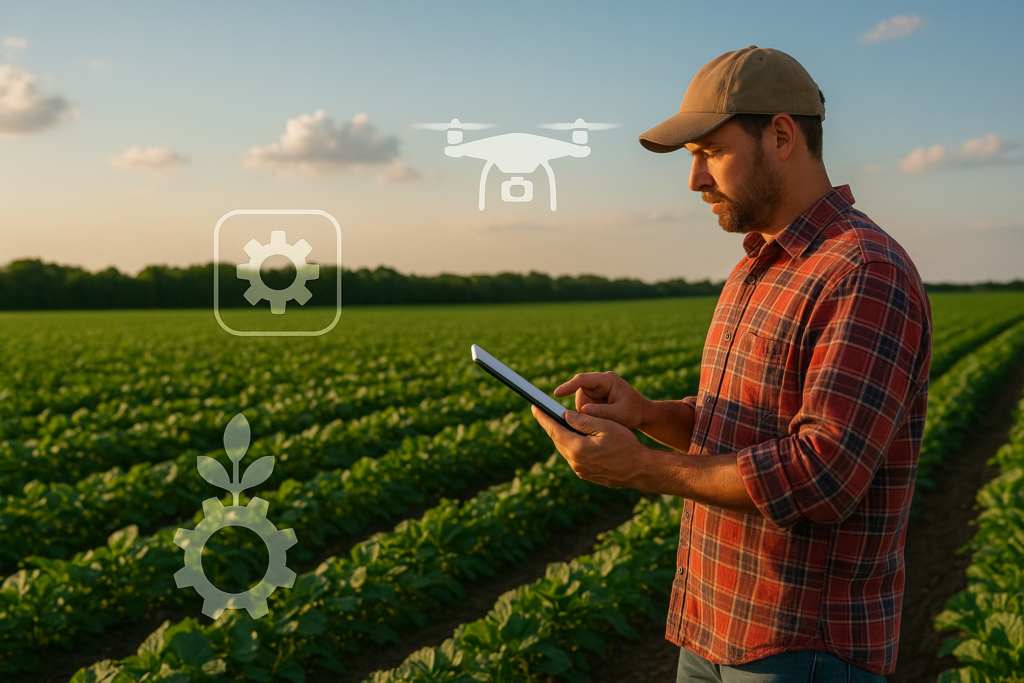
Smart farming technology is the cutting-edge application of information technologies in agriculture. It integrates IoT devices, drones, sensors, and GPS technologies to drastically improve the crop yield, reduce the waste produced, and improve the overall efficiency of the farmers.
This form of precision agriculture allows farmers to make use of data-driven decisions, helping them feed global population while conserving resources.
In this post, we will explore the components, benefits, and the future of smart farming and why it is valuable and how it will change agriculture forever compared to traditional farming methods.
Understanding the core of smart farming
What makes Farming smart
At its core, smart farming technology uses data and various sensors to analyse, monitor, and manage farming operations in real time. Unlike today’s traditional farming techniques, which depend mainly on human intuition, smart farming employs automation and real-time feedback of what is happening.
Key components include
- Internet of Things IoT Devices that monitor soil moisture, temperature, humidity, and livestock conditions
- Drones and Satellites Used for aerial surveillance, crop monitoring, and pest control
- Artificial Intelligence AI helps predict weather patterns, detect diseases, and optimize resource use
- Big Data Analytics Converts farm data into actionable insights
- GPS and GIS Mapping for precision planting, watering, and fertilization
Benefits of Smart Farming Technology
Why is Smart Farming so important
As there is a lot of climate change, resource scarcity, and food shortage, smart farming technology offers the best solution for this problem. Here is how it works to make a difference.
Increased crop productivity
Sensors and real-time data help the farmers know when and what their crop exactly needs. This precision and timing lead to better production and crop yield, and also healthier crops.
Reduced Environmental Impact
By the application of proper pesticides, fertilizers, and water when needed, smart farming minimizes the use of chemicals and also reduces water waste. This can not only improve farming but can also have a huge impact in reducing the pollution that can be harmful to our environment.
Lower Operational Costs
Automation reduces manual labour, fuel consumption, and input costs, making farming more financially sustainable for the farmers.
Real-time Monitoring
Whether it is soil pH or cattle health, farmers can constantly get updates on their phones through mobile apps or dashboards. This prevents small issues from turning into costly problems.
Data-driven Decision Making
It provides access to real-time and historical data, allowing for smarter planning and risk management overall.
Tools and Technologies in Smart Farming
What technologies are used in Smart Farming
Smart farming is not just a single tool for farming, but it is an ecosystem. Below are the most impactful technologies
- Smart Sensors Track soil conditions, plant health, and weather
- Autonomous Tractors and Machinery: GPS-guided equipment that plants, irrigates, and harvests with minimal human input
- Drones used to scan fields, assess plant health, and spray fertilizers or pesticides precisely
- Farm Management Software FMS helps in planning, budgeting, and logistics
Global trends in Smart Farming Technology
Is the world ready for Smart Farming?
Yes, and the shift is speeding up
Many countries like India, the US, the Netherlands, and Israel are heavily investing in smart farming technologies. According to industry reports, the smart agriculture market is expected to grow to over 30 billion dollars by the year 2030.
Factors driving this growth include
- Rising food demand due to population growth
- Increased investment in agritech startups
- Government incentives and subsidies for sustainable farming practices
- Technological advancements in IoT 5G and AI
Challenges to consider
What are the Limitations
Despite its promise, smart farming technology does have many hurdles
These include High Initial Costs, Equipmen,t and tech setup can be expensive
Skill Ga:p Farmers need training to use complex systems
Data Privacy Concerns: As more data is collected, securing it becomes critical
Infrastructure Needs Reliable internet and electricity are necessary for full functionality.
Final Thoughts
Smart farming technology is more than a buzzword; it is a game changer. By integrating data automation and AI, it allows for efficient, sustainable, and profitable agriculture. As the world faces growing environmental and food security challenges, using technology and integrating it into our agricultural systems can hugely boost our agricultural produce and yield. Moreover, adopting smart farming could be the key to a greener, more abundant future.
Find more of our posts at informationatoz.com